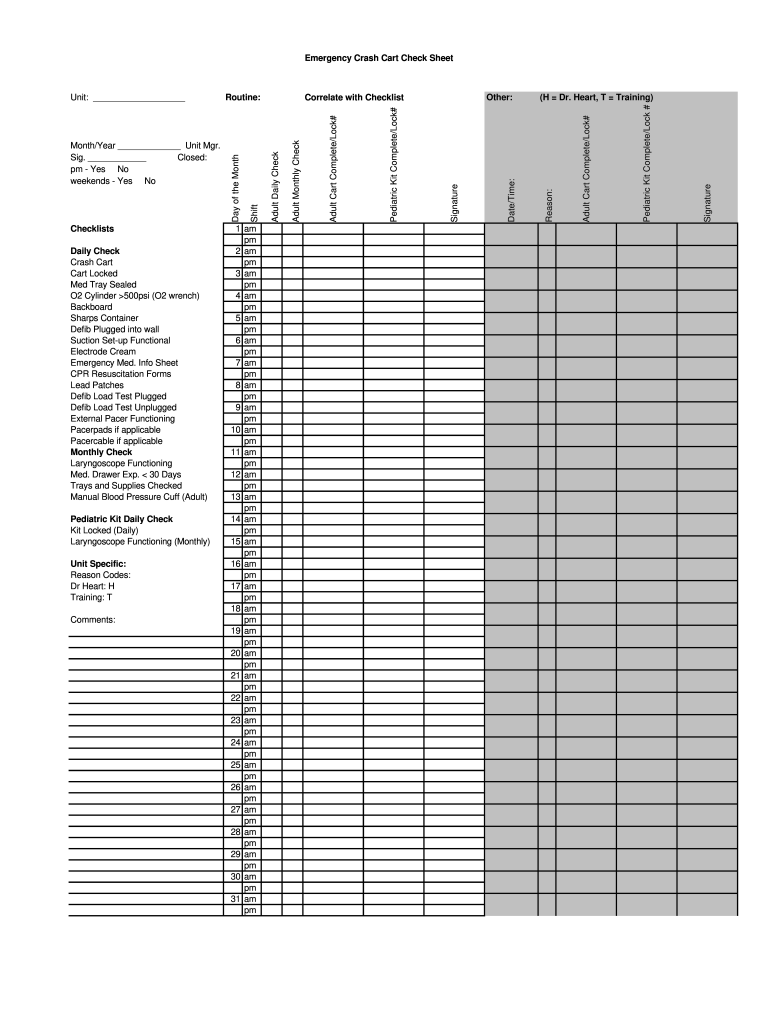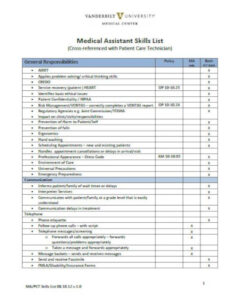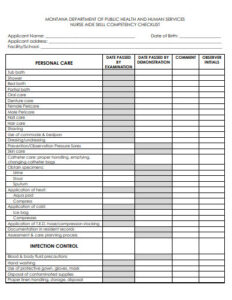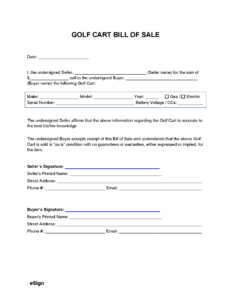In the demanding world of healthcare, every second counts, especially when a patient’s life hangs in the balance. A crash cart, often seen as a mobile emergency room, is the cornerstone of rapid response in critical situations. Ensuring this vital resource is always ready and fully stocked isn’t just good practice; it’s a fundamental commitment to patient safety and operational excellence. The sheer volume of items, from life-saving medications to essential medical equipment, makes a thorough, consistent check absolutely indispensable.
That’s where a well-structured daily crash cart checklist template comes into play. It transforms a potentially overwhelming task into a systematic, manageable routine. Imagine the peace of mind knowing that when an emergency strikes, your team won’t waste precious moments searching for a specific item or discovering an expired medication. This proactive approach not only enhances efficiency but significantly reduces the margin for error, allowing your healthcare professionals to focus entirely on providing the best possible care during a crisis.
Why a Daily Crash Cart Checklist is Non-Negotiable
Emergencies in a clinical setting are unpredictable and often arrive without warning. When they do, the immediate availability and functionality of every single item on the crash cart can be the difference between a successful resuscitation and a tragic outcome. This isn’t just about having the cart present; it’s about its comprehensive readiness, from the defibrillator paddles to the smallest syringe. Without a structured approach, the critical nature of these checks can sometimes be underestimated or, worse, overlooked entirely amidst the daily rush of patient care.

The consequences of an unprepared crash cart can be severe. Delays in administering life-saving medications because they’re expired or missing, equipment failures due to uncharged batteries, or simply not finding the right size airway adjunct can escalate an already dire situation. Beyond the immediate patient harm, such incidents can lead to immense stress for the healthcare team, potential legal ramifications for the facility, and a significant blow to the morale and confidence of staff. A daily check serves as a preventative shield against these very real and devastating scenarios.
Implementing a daily crash cart checklist template helps standardize the inspection process across all shifts and personnel. It removes guesswork, ensuring that every critical point is examined consistently, regardless of who is performing the check. This standardization fosters a culture of accountability and precision, where every team member understands their role in maintaining this essential piece of equipment. It also acts as a vital training tool for new staff, familiarizing them with the cart’s contents and the importance of thoroughness.
Furthermore, a consistent checklist empowers your team. Knowing that the crash cart has been meticulously inspected and is fully prepared instills a deep sense of confidence. This confidence allows them to act swiftly and decisively during an emergency, without the added burden of doubting their tools. It minimizes cognitive load during high-stress situations, letting medical professionals focus their expertise where it matters most: on the patient.
Ultimately, the commitment to a daily check reinforces the overarching goal of healthcare: patient safety. It demonstrates a dedication to operational excellence and a proactive stance against potential crises. It’s a small but profoundly impactful daily ritual that contributes significantly to the overall quality of care provided in any medical environment, creating a robust safety net for both patients and the healthcare providers who serve them.
Key Areas to Inspect During Your Daily Check
- **Medications:** Verify all medications are present, in correct quantities, unexpired, and properly secured. This includes checking for tamper seals where applicable.
- **Equipment:** Ensure the defibrillator is charged, functional, and has all necessary attachments. Check the patency of suction apparatus, the integrity of oxygen tanks, and the functionality of any monitoring devices.
- **Airway Management Supplies:** Confirm all sizes of intubation equipment, masks, and adjuncts are available and in good condition.
- **IV Access Supplies:** Check for various gauge catheters, tubing, and fluids, ensuring they are sterile and unexpired.
- **General Supplies:** Inspect gloves, syringes, needles, dressings, and other consumables for presence, quantity, and expiration dates.
- **Security and Documentation:** Confirm any tamper seals are intact and that the crash cart log sheet is present and ready for daily sign-off.
Building Your Custom Daily Crash Cart Checklist Template
While many excellent examples of a daily crash cart checklist template exist, the most effective one for your facility will often be a customized version. Every healthcare environment has unique needs, patient populations, and specific protocols that dictate the precise contents and organization of its crash carts. What works perfectly in a bustling emergency department might need significant adjustments for a long-term care facility or an outpatient clinic. The process of tailoring this essential document ensures it accurately reflects your operational reality and clinical priorities.
Begin by involving a multidisciplinary team in its development or review. This group should include nurses, physicians, pharmacists, and potentially biomedical technicians who regularly interact with the crash cart. Their collective insights will be invaluable in identifying critical items, common pain points, and areas where clarity is most needed. Consider your facility’s most common emergency scenarios and ensure the cart is equipped to handle them effectively. This collaborative approach not only creates a more comprehensive checklist but also fosters greater buy-in and adherence from the staff who will be using it daily.
When designing the checklist, prioritize clarity and ease of use. The language should be straightforward, avoiding ambiguity, and the layout should be logical and intuitive. Grouping similar items together, such as all airway supplies or all IV medications, can streamline the checking process and reduce the chance of oversight. Incorporate checkboxes for each item, allowing for quick visual confirmation, and include sections for date, time, and the initials of the person performing the check. This documentation is crucial for accountability and for tracking maintenance over time.
Don’t treat your daily crash cart checklist template as a static document. Clinical practices evolve, new equipment is introduced, and medication guidelines change. Establish a regular review cycle, perhaps annually or whenever significant changes occur in protocols or supplies. Solicit feedback from staff on an ongoing basis to identify areas for improvement. Regular training and refreshers for all personnel on the proper use of the checklist and the contents of the crash cart will further ensure its effectiveness and reinforce its importance within your facility’s safety culture.
Maintaining a meticulously prepared crash cart is not merely a task; it’s a critical safety measure that underpins the readiness of your entire care team. It reflects a deep commitment to proactive patient care and instills confidence in both staff and the individuals they serve. By consistently applying a thorough daily check, you’re building a robust foundation for effective emergency response, ensuring that when moments matter most, everything is in its place and ready for immediate use.
This dedication to detail translates directly into improved patient outcomes and a safer working environment for healthcare professionals. The peace of mind that comes from knowing every piece of equipment and every medication is accounted for and functional is immeasurable. It allows your team to focus their expertise on the immediate needs of the patient, providing the highest standard of care without the added burden of preventable delays or equipment failures.



